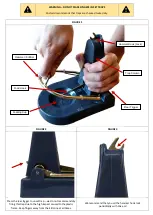
Where to set the traps
When setting traps you will need to look for a regular run as rodents follow wall/floor junctions, particularly under kitchen cupboards,
under baths, etc. They will run along beams, ceiling joists in lofts and alongside floor joists beneath the floor. Runs can be identified
through the presence of greasy marks, droppings or flattened vegetation.
It is recommended that traps are placed in voids away from human habitation, such as under kitchen cupboards or in the attic
space rather than in open areas. This will significantly improve the rate of capture.
Safety when trapping
Rats and mice carry many pathogens and therefore it is important to ensure that anyone handling traps or working in areas where
rats and mice have been active manage this risk. This can be achieved by following the guidelines below:
•
Avoid touching rats and mice or objects they may have contaminated.
•
Always wear disposable gloves when handling bodies, traps or when cleaning soiled areas.
•
Avoid stirring up and breathing dust in areas where rats and mice have been active.
•
Wear a mask to avoid breathing dust particles contaminated by rats or mice.
•
Use a disinfectant to dampen soiled nesting material and droppings before sweeping to reduce the amount of dust.
•
Always wash your hands after working with rats or mice even if you have been wearing gloves.
Removal of dead rodents
Domestic: The trap design removes the need to handle captured bodies. Simply release the trap as shown below ensuring the rodent
drops into a double bag, which can then be disposed of in the general waste.
Commercial: Rats and mice bodies are treated as non-hazardous waste under code EWC 20 01 99.
What to do at the end of the trapping
Once control of the population has been achieved steps should be taken to prevent reoccurrence. Proofing of entry points is a
common tool used to help prevent reoccurrence, some common proofing examples are given below:
•
Mice can gain access through a hole of approximately 5mm in diameter, rats slightly larger.
•
Install wire wool or mesh to entrance gaps and pipe work in both internal and external locations.
•
Bristle strips should be installed to door bases.
•
Mesh guards should be fitted to ventilation bricks.
•
Caps should be placed on the top of drainpipes to prevent rats accessing the pipes.
•
Broken drains must be repaired where rats have used these to access building cavities.
•
Cutting back ivy and other climbing plants to below soffit level will remove a common access path.
















